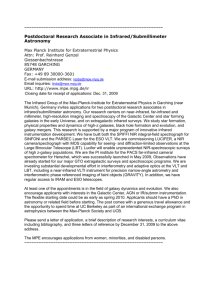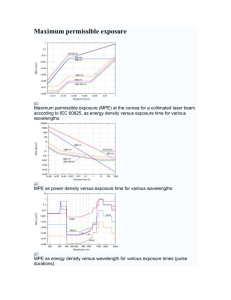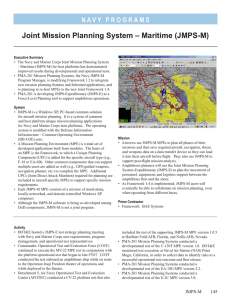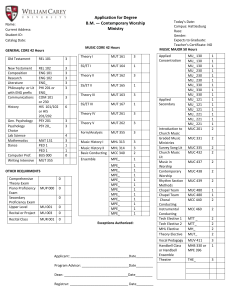Mission Planning System (MPS)
advertisement
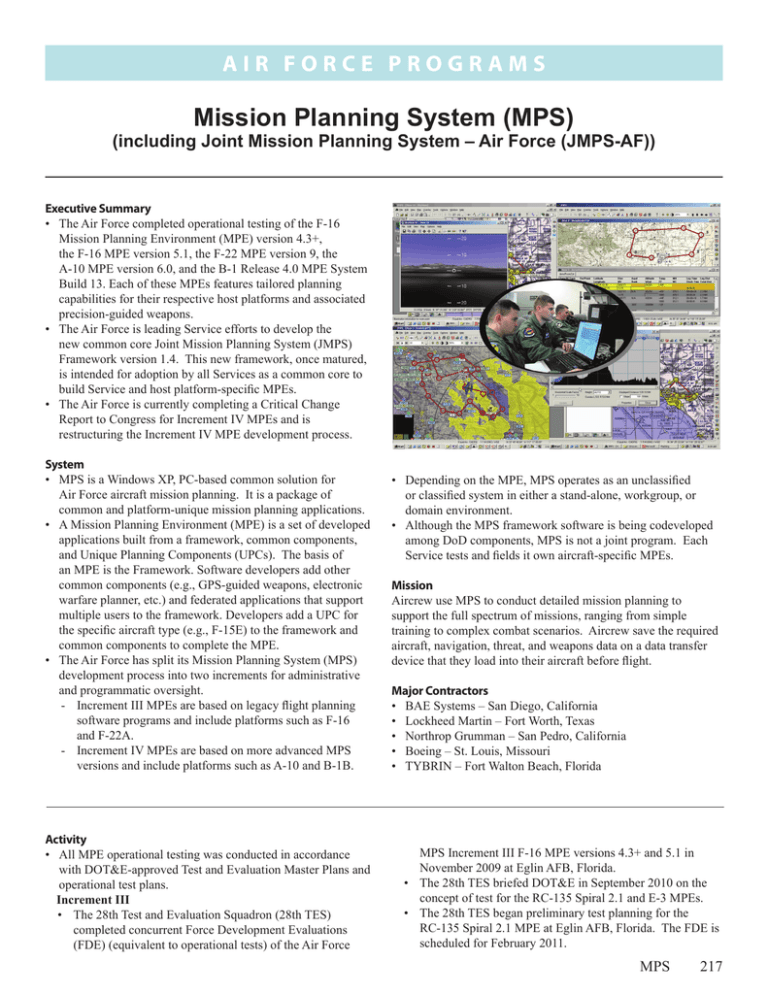
Ai r F o r c e P ROGRAMS Mission Planning System (MPS) (including Joint Mission Planning System – Air Force (JMPS-AF)) Executive Summary • The Air Force completed operational testing of the F-16 Mission Planning Environment (MPE) version 4.3+, the F-16 MPE version 5.1, the F-22 MPE version 9, the A-10 MPE version 6.0, and the B-1 Release 4.0 MPE System Build 13. Each of these MPEs features tailored planning capabilities for their respective host platforms and associated precision-guided weapons. • The Air Force is leading Service efforts to develop the new common core Joint Mission Planning System (JMPS) Framework version 1.4. This new framework, once matured, is intended for adoption by all Services as a common core to build Service and host platform-specific MPEs. • The Air Force is currently completing a Critical Change Report to Congress for Increment IV MPEs and is restructuring the Increment IV MPE development process. System • MPS is a Windows XP, PC-based common solution for Air Force aircraft mission planning. It is a package of common and platform-unique mission planning applications. • A Mission Planning Environment (MPE) is a set of developed applications built from a framework, common components, and Unique Planning Components (UPCs). The basis of an MPE is the Framework. Software developers add other common components (e.g., GPS-guided weapons, electronic warfare planner, etc.) and federated applications that support multiple users to the framework. Developers add a UPC for the specific aircraft type (e.g., F-15E) to the framework and common components to complete the MPE. • The Air Force has split its Mission Planning System (MPS) development process into two increments for administrative and programmatic oversight. - Increment III MPEs are based on legacy flight planning software programs and include platforms such as F-16 and F-22A. - Increment IV MPEs are based on more advanced MPS versions and include platforms such as A-10 and B-1B. Activity • All MPE operational testing was conducted in accordance with DOT&E-approved Test and Evaluation Master Plans and operational test plans. Increment III • The 28th Test and Evaluation Squadron (28th TES) completed concurrent Force Development Evaluations (FDE) (equivalent to operational tests) of the Air Force • Depending on the MPE, MPS operates as an unclassified or classified system in either a stand-alone, workgroup, or domain environment. • Although the MPS framework software is being codeveloped among DoD components, MPS is not a joint program. Each Service tests and fields it own aircraft-specific MPEs. Mission Aircrew use MPS to conduct detailed mission planning to support the full spectrum of missions, ranging from simple training to complex combat scenarios. Aircrew save the required aircraft, navigation, threat, and weapons data on a data transfer device that they load into their aircraft before flight. Major Contractors • BAE Systems – San Diego, California • Lockheed Martin – Fort Worth, Texas • Northrop Grumman – San Pedro, California • Boeing – St. Louis, Missouri • TYBRIN – Fort Walton Beach, Florida MPS Increment III F-16 MPE versions 4.3+ and 5.1 in November 2009 at Eglin AFB, Florida. • The 28th TES briefed DOT&E in September 2010 on the concept of test for the RC-135 Spiral 2.1 and E-3 MPEs. • The 28th TES began preliminary test planning for the RC-135 Spiral 2.1 MPE at Eglin AFB, Florida. The FDE is scheduled for February 2011. MPS 217 Ai r F o r c e P ROGRAMS • Air Force Operational Test and Evaluation Center (AFOTEC) Detachment 2 completed the Air Force MPS Increment III F-22 MPE version 9 operational test in October and November 2009 at Nellis AFB, Nevada. • The 28th TES initiated the FDE of Air Force MPS Increment III F-22 MPE version 11 in July 2010 at Eglin AFB, Florida. This FDE is scheduled for completion in FY11. Increment IV • The 28th TES conducted the FDE of the Air Force MPS Increment IV A-10 MPE version 6.0 in June 2010 at Barksdale AFB, Louisiana. • The 28th TES conducted the FDE of the Air Force MPS Increment IV B-1 Release 4.0 System Build 13 MPE in July 2010 at Dyess AFB, Texas. • The 28th TES conducted advanced planning in support of the E-3 MPE FDE in November 2010 at Tinker AFB, Oklahoma. • In conjunction with the 28th TES, AFOTEC Detachment 2 conducted advanced planning to conduct operational testing of the E-8 MPE in May 2011 at Robins AFB, Georgia. The E-8 MPE is the representative test platform for Increment IV mission planning functionality. Assessment Increment III F-16 MPEs • F-16 MPE version 4.3+ operational test results showed that the High Speed Anti-Radiation Missile (HARM) Targeting System (HTS) Training Mode Tool did not function properly. Also, the Joint Air-to-Surface Standoff Missile (JASSM) planning module was slow and difficult to use. The Take-off and Landing Data (TOLD) module generated incorrect data and is not certified for use. Installation of the MPE on host computers was a slow and complex procedure. The F-16 MPE version 4.3+ Mean Time Between Critical Failure (MTBCF) was 29.5 hours versus a threshold of 2.0 hours. • F-16 MPE version 5.1 operational testing highlighted that developers had fixed the HTS Targeting System Training Tool discrepancy from MPE 4.3+ in this MPE. MPE version 5.1 MTBCF was 48.5 hours versus a threshold of 2.0 hours. The Take-off and Landing Data (TOLD) module generated incorrect data and is not certified for use. Installation of the MPE on host computers remains slow. Increment III F-22 MPEs • F-22 MPE version 9 operational testing showed that the operational test aircrew were able to plan missions within the Key Performance Parameter threshold requirement of 120 minutes, with a mean time to plan over 125 missions of 72 minutes. The F-22A Flight Performance Module software application provided erroneous fuel calculations. The automatic optimum routing application performed 218 MPS unsatisfactorily and provided plans that had the aircraft fly over threats that were resident in the database. The MPE demonstrated a MTBCF of 235.2 hours, exceeding the threshold requirement of 9.0 hours. • DOT&E is still assessing the F-22 MPE version 11 FDE. This test was completed in two phases due to lack of combat aircrew availability; however, it was ultimately completed in September 2010. This MPE contains a number of fixes for version 9 deficiencies discovered during developmental and operational testing. Emerging results indicate users new to JMPS planning encountered no significant problems in learning and using the MPE during FDE testing. Increment IV • Lack of available aircrew led to two very experienced aircrew conducting operational testing on the A-10 MPE version 6.0. Test aircrew used A-10 MPE version 6.0 to plan missions well within the 120-minute requirement with a mean time to plan over 36 missions of 35 minutes per mission. However, less experienced users are likely to need extensive training to effectively plan missions. The MPE locks up too frequently and displays non-specific error messages. Installation of the MPE on the host computer equipment was complex and slow; installation help desk support was not always available and was uneven in quality. The MPE had two critical failures in 37.35 hours of test for a MTBCF of 18.7 hours; MTBCF threshold is 2.0 hours. • B-1B Release 4.0 System Build 13 MPE operational testing showed that users’ mean time to plan a mission was 59 minutes, well within the 7-hour requirement. TOLD data generated by the MPE did not agree with data generated by the B-1 Technical Order and were not certified for flight. The MPE did not experience a critical failure in more than 62 hours of operation, exceeding its MTBCF threshold requirement of 7 hours. Recommendations • Status of Previous Recommendations. The Air Force did not complete the FY09 recommendation to update the draft MPS Increment IV TEMP operational test strategy, focusing on early and continuous reliability growth and information assurance vulnerability testing. • FY10 Recommendations. In addition to addressing the above recommendation, the Air Force should: 1. Plan for adequate numbers of appropriately qualified personnel and sufficient funding to be involved in the Increment IV IOT&E and later FDE spiral testing. 2. Develop and implement a dedicated process to implement required fixes to flight performance monitor TOLD data within all MPE’s in order to eliminate bureaucratic delays with certification/de-certification of TOLD data for operational use.

